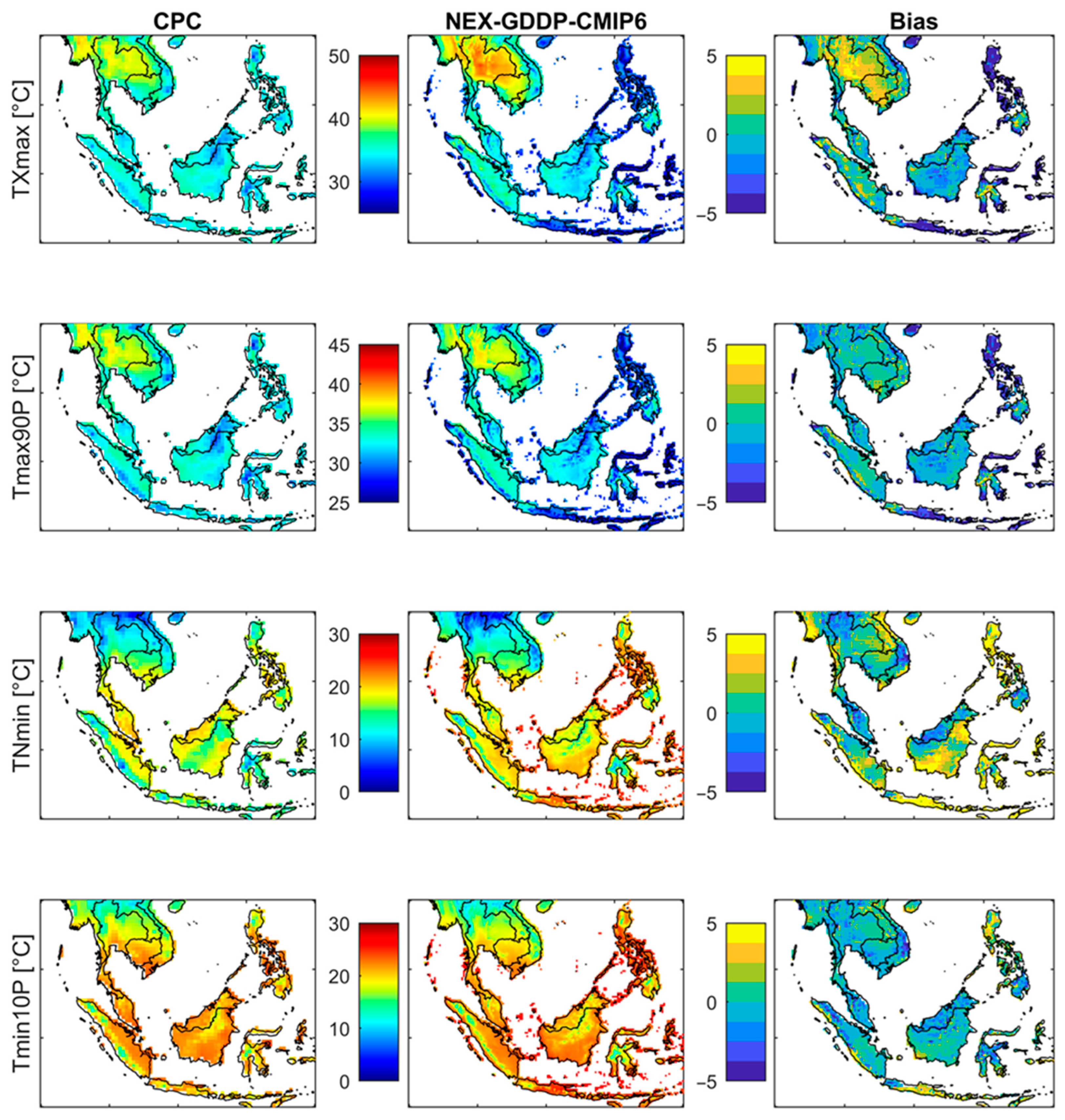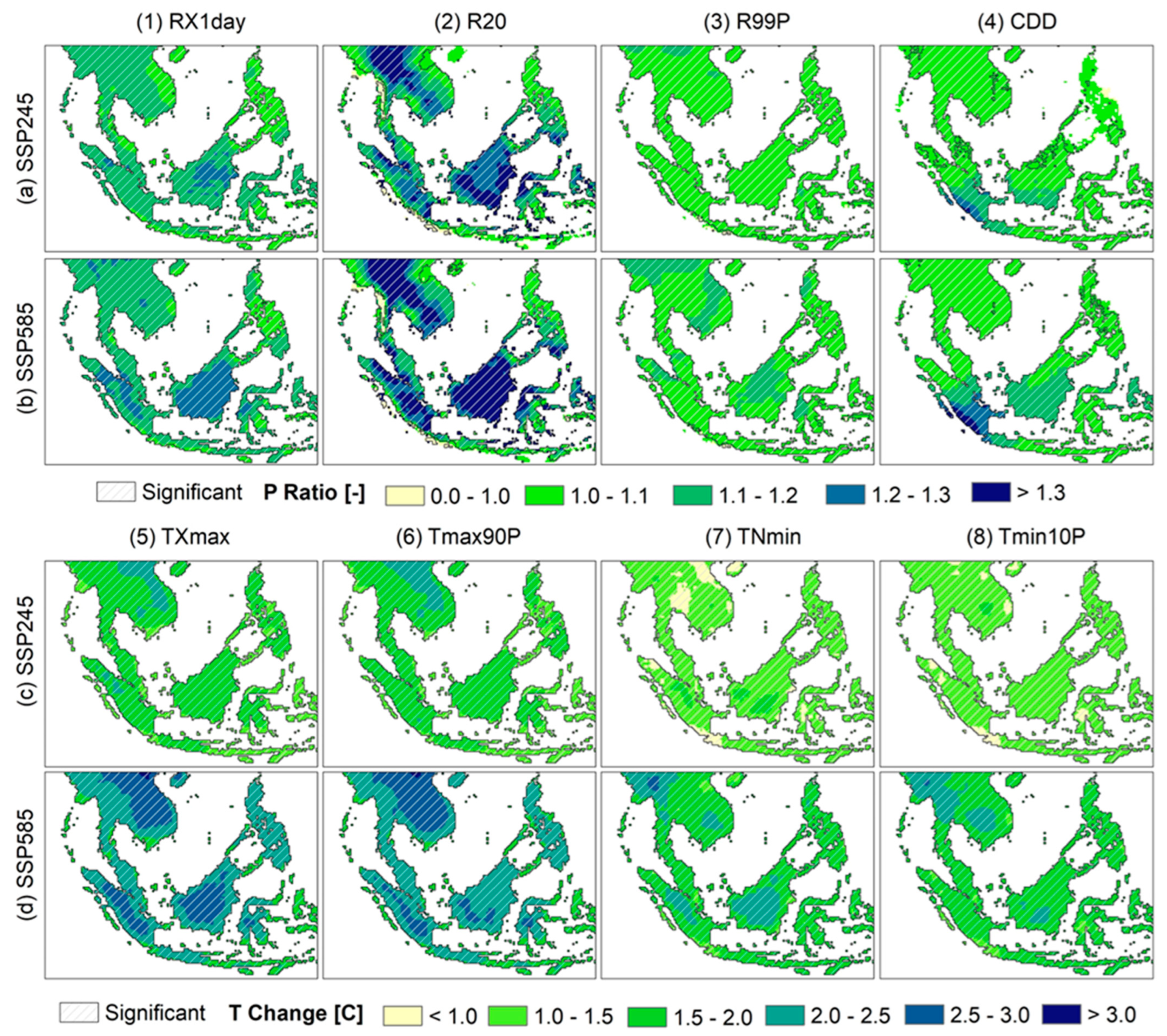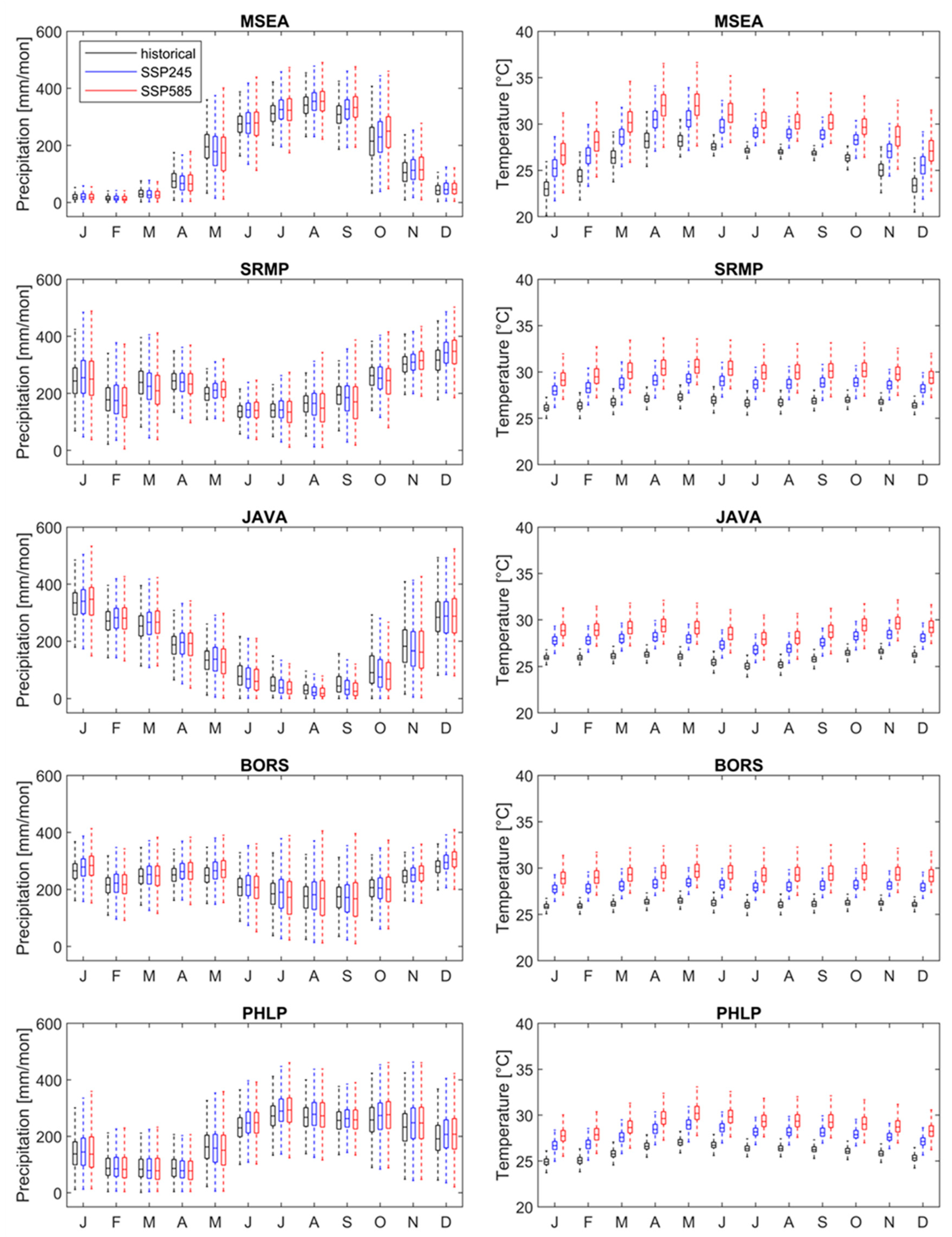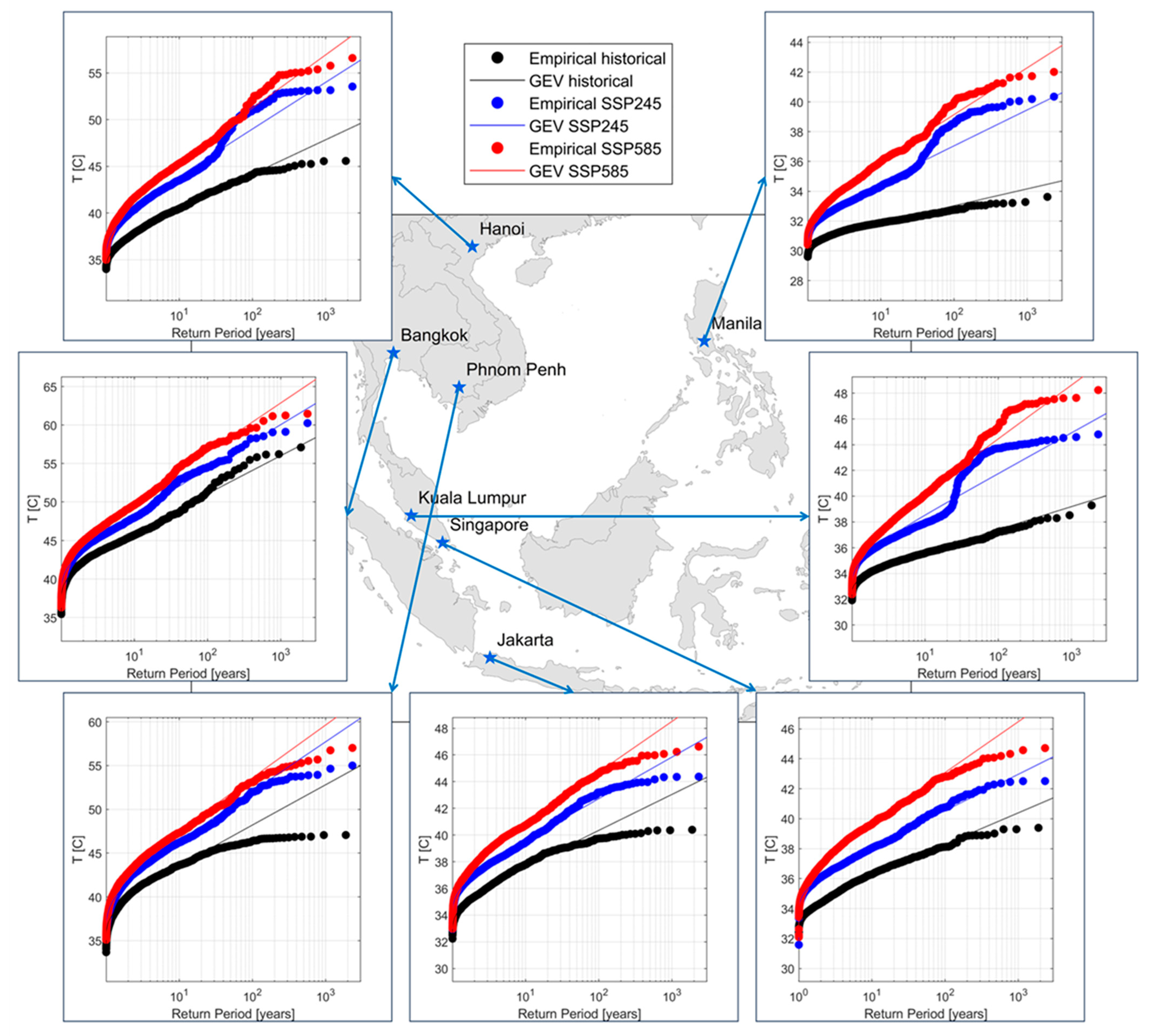Evaluation of Future Changes in Climate Extremes over Southeast Asia Using Downscaled CMIP6 GCM Projections
Abstract
:1. Introduction
2. Data and Methods
2.1. Study Area
2.2. Datasets and Indices
2.3. Statistical Test and Indicators
2.3.1. K-S Two Parameter Test
2.3.2. Extreme Value Analysis
2.3.3. SPAEF Index
2.3.4. FSS Index
2.3.5. Analysis Procedure
3. Results
3.1. Historical Verification
3.2. Future Projection
3.2.1. Projection of Precipitation Changes
3.2.2. Projection of Temperature Changes
3.3. Seasonal Changes
3.4. Localization Outlooks
4. Discussion and Conclusions
Supplementary Materials
Author Contributions
Funding
Data Availability Statement
Acknowledgments
Conflicts of Interest
References
- Adeyeri, O.E.; Zhou, W.; Wang, X.; Zhang, R.; Laux, P.; Ishola, K.A.; Usman, M. The trend and spatial spread of multisectoral climate extremes in CMIP6 models. Sci. Rep. 2022, 12, 21000. [Google Scholar] [CrossRef] [PubMed]
- Chhin, R.; Oeurng, C.; Yoden, S. Drought projection in the Indochina Region based on the optimal ensemble subset of CMIP5 models. Clim. Chang. 2020, 162, 687–705. [Google Scholar] [CrossRef]
- Iqbal, Z.; Shahid, S.; Ahmed, K.; Ismail, T.; Ziarh, G.F.; Chung, E.-S.; Wang, X. Evaluation of CMIP6 GCM rainfall in mainland Southeast Asia. Atmos. Res. 2021, 254, 105525. [Google Scholar] [CrossRef]
- Thrasher, B.; Wang, W.; Michaelis, A.; Melton, F.; Lee, T.; Nemani, R. NASA global daily downscaled projections, CMIP6. Sci. Data 2022, 9, 262. [Google Scholar] [CrossRef] [PubMed]
- Try, S.; Sayama, T.; Phy, S.R.; Sok, T.; Ly, S.; Oeurng, C. Assessing the impacts of climate change and dam development on potential flood hazard and damages in the Cambodian floodplain of the lower mekong basin. J. Hydrol. Reg. Stud. 2023, 49, 101508. [Google Scholar] [CrossRef]
- Bourdeau-Goulet, S.; Hassanzadeh, E. Comparisons between CMIP5 and CMIP6 models: Simulations of climate indices influencing food security, infrastructure resilience, and human health in Canada. Earth’s Future 2021, 9, e2021EF001995. [Google Scholar] [CrossRef]
- Chen, H.; Sun, J.; Lin, W.; Xu, H. Comparison of CMIP6 and CMIP5 models in simulating climate extremes. Sci. Bull. 2020, 65, 1415–1418. [Google Scholar] [CrossRef] [PubMed]
- Seneviratne, S.I.; Hauser, M. Regional climate sensitivity of climate extremes in CMIP6 versus CMIP5 multimodel ensembles. Earth’s Future 2020, 8, e2019EF001474. [Google Scholar] [CrossRef]
- Try, S.; Tanaka, S.; Tanaka, K.; Sayama, T.; Khujanazarov, T.; Oeurng, C. Comparison of CMIP5 and CMIP6 GCM performance for flood projections in the Mekong River Basin. J. Hydrol. Reg. Stud. 2022, 40, 101035. [Google Scholar] [CrossRef]
- Murphy, J.M.; Sexton, D.M.; Barnett, D.N.; Jones, G.S.; Webb, M.J.; Collins, M.; Stainforth, D.A. Quantification of modelling uncertainties in a large ensemble of climate change simulations. Nature 2004, 430, 768–772. [Google Scholar] [CrossRef]
- Chhin, R.; Yoden, S. Ranking CMIP5 GCMs for model ensemble selection on regional scale: Case study of the Indochina Region. J. Geophys. Res. Atmos. 2018, 123, 8949–8974. [Google Scholar] [CrossRef]
- Desmet, Q.; Ngo-Duc, T. A novel method for ranking CMIP6 global climate models over the southeast Asian region. Int. J. Climatol. 2022, 42, 97–117. [Google Scholar] [CrossRef]
- Ge, F.; Zhu, S.; Luo, H.; Zhi, X.; Wang, H. Future changes in precipitation extremes over Southeast Asia: Insights from CMIP6 multi-model ensemble. Environ. Res. Lett. 2021, 16, 024013. [Google Scholar] [CrossRef]
- Le, P.V.; Randerson, J.T.; Willett, R.; Wright, S.; Smyth, P.; Guilloteau, C.; Mamalakis, A.; Foufoula-Georgiou, E. Climate-driven changes in the predictability of seasonal precipitation. Nat. Commun. 2023, 14, 3822. [Google Scholar] [CrossRef] [PubMed]
- Peng, S.; Wang, C.; Li, Z.; Mihara, K.; Kuramochi, K.; Toma, Y.; Hatano, R. Climate change multi-model projections in CMIP6 scenarios in Central Hokkaido, Japan. Sci. Rep. 2023, 13, 230. [Google Scholar] [CrossRef] [PubMed]
- Rettie, F.M.; Gayler, S.; Weber, T.K.; Tesfaye, K.; Streck, T. High-resolution CMIP6 climate projections for Ethiopia using the gridded statistical downscaling method. Sci. Data 2023, 10, 442. [Google Scholar] [CrossRef] [PubMed]
- Rummukainen, M. State-of-the-art with regional climate models. Wiley Interdiscip. Rev. Clim. Change 2010, 1, 82–96. [Google Scholar] [CrossRef]
- Giorgi, F.; Francisco, R. Evaluating uncertainties in the prediction of regional climate change. Geophys. Res. Lett. 2000, 27, 1295–1298. [Google Scholar] [CrossRef]
- Supharatid, S.; Nafung, J.; Aribarg, T. Projected changes in temperature and precipitation over mainland Southeast Asia by CMIP6 models. J. Water Clim. Change 2022, 13, 337–356. [Google Scholar] [CrossRef]
- Ge, F.; Zhi, X.; Babar, Z.A.; Tang, W.; Chen, P. Interannual variability of summer monsoon precipitation over the Indochina Peninsula in association with ENSO. Theor. Appl. Climatol. 2017, 128, 523–531. [Google Scholar] [CrossRef]
- Takahashi, H.G.; Yasunari, T. Decreasing trend in rainfall over Indochina during the late summer monsoon: Impact of tropical cyclones. J. Meteorol. Soc. Japan. Ser. II 2008, 86, 429–438. [Google Scholar] [CrossRef]
- Wang, B.; Wu, R.; Lau, K. Interannual variability of the Asian summer monsoon: Contrasts between the Indian and the western North Pacific–East Asian monsoons. J. Clim. 2001, 14, 4073–4090. [Google Scholar] [CrossRef]
- Faostat, F. Statistical Database; Food and Agriculture Organization of the United Nations: Rome, Italy, 2017. [Google Scholar]
- Qin, X.; Dai, C. Comparison of different quantile delta mapping schemes in frequency analysis of precipitation extremes over mainland Southeast Asia under climate change. J. Hydrol. 2022, 606, 127421. [Google Scholar] [CrossRef]
- Skliris, N.; Marsh, R.; Haigh, I.D.; Wood, M.; Hirschi, J.; Darby, S.; Quynh, N.P.; Hung, N.N. Drivers of rainfall trends in and around Mainland Southeast Asia. Front. Clim. 2022, 4, 926568. [Google Scholar] [CrossRef]
- Endo, N.; Matsumoto, J.; Lwin, T. Trends in precipitation extremes over Southeast Asia. Sola 2009, 5, 168–171. [Google Scholar] [CrossRef]
- Hariadi, M.H.; van der Schrier, G.; Steeneveld, G.; Ratri, D.N.; Sopaheluwakan, A.; Tank, A.K.; Aldrian, E.; Gunawan, D.; Moine, M.; Bellucci, A. Evaluation of extreme precipitation over Southeast Asia in the Coupled Model Intercomparison Project Phase 5 regional climate model results and HighResMIP global climate models. Int. J. Climatol. 2023, 43, 1639–1659. [Google Scholar] [CrossRef]
- Mandapaka, P.V.; Lo, E.Y. Assessment of future changes in Southeast Asian precipitation using the NASA Earth Exchange Global Daily Downscaled Projections data set. Int. J. Climatol. 2018, 38, 5231–5244. [Google Scholar] [CrossRef]
- Singh, V.; Qin, X. Study of rainfall variabilities in Southeast Asia using long-term gridded rainfall and its substantiation through global climate indices. J. Hydrol. 2020, 585, 124320. [Google Scholar] [CrossRef]
- Tangang, F.; Juneng, L.; Cruz, F.; Chung, J.X.; Ngai, S.T.; Salimun, E.; Mohd, M.S.F.; Santisirisomboon, J.; Singhruck, P.; PhanVan, T. Multi-model projections of precipitation extremes in Southeast Asia based on CORDEX-Southeast Asia simulations. Environ. Res. 2020, 184, 109350. [Google Scholar]
- Kim, I.-W.; Oh, J.; Woo, S.; Kripalani, R. Evaluation of precipitation extremes over the Asian domain: Observation and modelling studies. Clim. Dyn. 2019, 52, 1317–1342. [Google Scholar] [CrossRef]
- Liu, S.; Raghavan, S.V.; Ona, B.J.; Nguyen, N.S. Bias evaluation in rainfall over Southeast Asia in CMIP6 models. J. Hydrol. 2023, 621, 129593. [Google Scholar] [CrossRef]
- Ly, S.; Sayama, T.; Try, S. Integrated impact assessment of climate change and hydropower operation on streamflow and inundation in the lower Mekong Basin. Prog. Earth Planet. Sci. 2023, 10, 55. [Google Scholar] [CrossRef]
- Thanvisitthpon, N.; Shrestha, S.; Pal, I. Urban flooding and climate change: A case study of Bangkok, Thailand. Environ. Urban. ASIA 2018, 9, 86–100. [Google Scholar] [CrossRef]
- Worawiwat, A.; Chaleeraktrakoon, C.; Sharma, A. Is Increased Flooding Bangk. A Result Rising Local Temp? J. Hydrol. X 2021, 13, 100095. [Google Scholar]
- Duy, P.; Chapman, L.; Tight, M.; Thuong, L.; Linh, P. Urban resilience to floods in coastal cities: Challenges and opportunities for Ho Chi Minh city and other emerging cities in southeast Asia. J. Urban Plan. Dev. 2018, 144, 05017018. [Google Scholar] [CrossRef]
- Luo, P.; Mu, D.; Xue, H.; Ngo-Duc, T.; Dang-Dinh, K.; Takara, K.; Nover, D.; Schladow, G. Flood inundation assessment for the Hanoi Central Area, Vietnam under historical and extreme rainfall conditions. Sci. Rep. 2018, 8, 12623. [Google Scholar] [CrossRef]
- Heng, S.; Ly, S.; Chhem, S.; Kruy, P. Analysis of Public Perceptions on Urban Flood in Phnom Penh, Cambodia. In Water Security in Asia: Opportunities and Challenges in the Context of Climate Change; Springer: Berlin/Heidelberg, Germany, 2021; pp. 687–701. [Google Scholar]
- Thuon, T.; Cai, Y. Resistance for resilience: A reflexive exploration of battambang, Cambodia. In Urban Climate Resilience in Southeast Asia; Springer: Cham, Swizerland, 2019; pp. 127–146. [Google Scholar]
- Reeder, G. Urban Governance of flooding in Myanmar: A case study of bago. In Urban Climate Resilience in Southeast Asia; Springer: Cham, Swizerland, 2019; pp. 103–126. [Google Scholar]
- Zin, W.W.; Kawasaki, A.; Takeuchi, W.; San, Z.M.L.T.; Htun, K.Z.; Aye, T.H.; Win, S. Flood hazard assessment of Bago river basin, Myanmar. J. Disaster Res. 2018, 13, 14–21. [Google Scholar] [CrossRef]
- Phanuwan, C.; Takizawa, S.; Oguma, K.; Katayama, H.; Yunika, A.; Ohgaki, S. Monitoring of human enteric viruses and coliform bacteria in waters after urban flood in Jakarta, Indonesia. Water Sci. Technol. 2006, 54, 203–210. [Google Scholar] [CrossRef] [PubMed]
- Rendana, M.; Mohd Razi Idris, W.; Abdul Rahim, S.; Abdo, H.G.; Almohamad, H.; Abdullah Al Dughairi, A. Flood risk and shelter suitability mapping using geospatial technique for sustainable urban flood management: A case study in Palembang city, South Sumatera, Indonesia. Geol. Ecol. Landsc. 2023, 1–11. [Google Scholar] [CrossRef]
- Garcia, F.C.C.; Retamar, A.E.; Javier, J.C. A real time urban flood monitoring system for metro Manila. In Proceedings of the TENCON 2015–2015 IEEE Region 10 Conference, Macao, China, 1–4 November 2015; pp. 1–5. [Google Scholar]
- Zoleta-Nantes, D.B. Flood hazards in Metro Manila: Recognizing commonalities, differences, and courses of action. Soc. Sci. Diliman 2007, 1, 60–105. [Google Scholar]
- Sayama, T.; Tatebe, Y.; Iwami, Y.; Tanaka, S. Hydrologic sensitivity of flood runoff and inundation: 2011 Thailand floods in the Chao Phraya River basin. Nat. Hazards Earth Syst. Sci. 2015, 15, 1617–1630. [Google Scholar] [CrossRef]
- MRC. Annual Mekong Flood Report 2011. Mekong River Commission, Vientiane, Lao PDR. 2015. Available online: https://reliefweb.int/report/cambodia/annual-mekong-flood-report-2011 (accessed on 25 May 2023).
- Budiyono, Y.; Aerts, J.C.; Tollenaar, D.; Ward, P.J. River flood risk in Jakarta under scenarios of future change. Nat. Hazards Earth Syst. Sci. 2016, 16, 757–774. [Google Scholar] [CrossRef]
- Lagmay, A.M.; Mendoza, J.; Cipriano, F.; Delmendo, P.A.; Lacsamana, M.N.; Moises, M.A.; Pellejera, N., III; Punay, K.N.; Sabio, G.; Santos, L. Street floods in Metro Manila and possible solutions. J. Environ. Sci. 2017, 59, 39–47. [Google Scholar] [CrossRef] [PubMed]
- Dutta, D. An integrated tool for assessment of flood vulnerability of coastal cities to sea-level rise and potential socio-economic impacts: A case study in Bangkok, Thailand. Hydrol. Sci. J. 2011, 56, 805–823. [Google Scholar] [CrossRef]
- Bhuiyan, T.R.; Reza, M.I.H.; Choy, E.A.; Pereira, J.J. Facts and trends of urban exposure to flash flood: A case of Kuala Lumpur City. In Improving Flood Management, Prediction and Monitoring; Emerald Publishing Limited: Bingley, UK, 2018; pp. 79–90. [Google Scholar]
- Vachaud, G.; Quertamp, F.; Phan, T.S.H.; Ngoc, T.D.T.; Nguyen, T.; Luu, X.L.; Nguyen, A.T.; Gratiot, N. Flood-related risks in Ho Chi Minh City and ways of mitigation. J. Hydrol. 2019, 573, 1021–1027. [Google Scholar] [CrossRef]
- Yatagai, A.; Kamiguchi, K.; Arakawa, O.; Hamada, A.; Yasutomi, N.; Kitoh, A. APHRODITE: Constructing a long-term daily gridded precipitation dataset for Asia based on a dense network of rain gauges. Bull. Am. Meteorol. Soc. 2012, 93, 1401–1415. [Google Scholar] [CrossRef]
- Noor, M.; Ismail, T.; Shahid, S.; Nashwan, M.S.; Ullah, S. Development of multi-model ensemble for projection of extreme rainfall events in Peninsular Malaysia. Hydrol. Res. 2019, 50, 1772–1788. [Google Scholar] [CrossRef]
- Sunilkumar, K.; Yatagai, A.; Masuda, M. Preliminary evaluation of GPM-IMERG rainfall estimates over three distinct climate zones with APHRODITE. Earth Space Sci. 2019, 6, 1321–1335. [Google Scholar] [CrossRef]
- Try, S.; Tanaka, S.; Tanaka, K.; Sayama, T.; Oeurng, C.; Uk, S.; Takara, K.; Hu, M.; Han, D. Comparison of gridded precipitation datasets for rainfall-runoff and inundation modeling in the Mekong River Basin. PLoS ONE 2020, 15, e0226814. [Google Scholar] [CrossRef]
- Chen, M.; Shi, W.; Xie, P.; Silva, V.B.; Kousky, V.E.; Wayne Higgins, R.; Janowiak, J.E. Assessing objective techniques for gauge-based analyses of global daily precipitation. J. Geophys. Res. Atmos. 2008, 113, D04110. [Google Scholar] [CrossRef]
- Haile, A.T.; Habib, E.; Rientjes, T. Evaluation of the climate prediction center (CPC) morphing technique (CMORPH) rainfall product on hourly time scales over the source of the Blue Nile River. Hydrol. Process. 2013, 27, 1829–1839. [Google Scholar] [CrossRef]
- McKinnon, K.A.; Rhines, A.; Tingley, M.; Huybers, P. Long-lead predictions of eastern United States hot days from Pacific sea surface temperatures. Nat. Geosci. 2016, 9, 389–394. [Google Scholar] [CrossRef]
- Sun, Q.; Miao, C.; Duan, Q.; Ashouri, H.; Sorooshian, S.; Hsu, K. A review of global precipitation data sets: Data sources, estimation, and intercomparisons. Rev. Geophys. 2018, 56, 79–107. [Google Scholar] [CrossRef]
- Wood, A.W.; Leung, L.R.; Sridhar, V.; Lettenmaier, D.P. Hydrologic implications of dynamical and statistical approaches to downscaling climate model outputs. Clim. Change 2004, 62, 189–216. [Google Scholar] [CrossRef]
- Thrasher, B.; Maurer, E.P.; McKellar, C.; Duffy, P.B. Technical Note: Bias correcting climate model simulated daily temperature extremes with quantile mapping. Hydrol. Earth Syst. Sci. 2012, 16, 3309–3314. [Google Scholar] [CrossRef]
- Zhang, X.; Alexander, L.; Hegerl, G.C.; Jones, P.; Tank, A.K.; Peterson, T.C.; Trewin, B.; Zwiers, F.W. Indices for monitoring changes in extremes based on daily temperature and precipitation data. Wiley Interdiscip. Rev. Clim. Change 2011, 2, 851–870. [Google Scholar] [CrossRef]
- Massey, F.J., Jr. The Kolmogorov-Smirnov test for goodness of fit. J. Am. Stat. Assoc. 1951, 46, 68–78. [Google Scholar] [CrossRef]
- Singh, V.P.; Singh, V.P. Generalized extreme value distribution. In Entropy-Based Parameter Estimation in Hydrology; Springer Nature: Dordrecht, The Netherlands, 1998; pp. 169–183. [Google Scholar]
- Demirel, M.C.; Mai, J.; Mendiguren, G.; Koch, J.; Samaniego, L.; Stisen, S. Combining satellite data and appropriate objective functions for improved spatial pattern performance of a distributed hydrologic model. Hydrol. Earth Syst. Sci. 2018, 22, 1299–1315. [Google Scholar] [CrossRef]
- Pearson, K. Early Statistical Papers; Cambridge University Press: Cambridge, UK, 1948; pp. 1–40. [Google Scholar]
- Roberts, N.M.; Lean, H.W. Scale-selective verification of rainfall accumulations from high-resolution forecasts of convective events. Mon. Weather. Rev. 2008, 136, 78–97. [Google Scholar] [CrossRef]
- Wu, Y.H.; Huang, C.Z.; Huang, W.W.; Chen, X.J. Projected changes in temperature and precipitation over Canada in the 21st Century. J. Environ. Inform. 2024. [Google Scholar] [CrossRef]







| Scenario | Region | RX1day | R20 | R99P | CDD | ||||
|---|---|---|---|---|---|---|---|---|---|
| Near Future | Far Future | Near Future | Far Future | Near Future | FAR Future | Near Future | Far Future | ||
| SSP245 | MSEA | 1.10 ** | 1.15 ** | 1.06 ** | 1.13 ** | 1.06 ** | 1.10 ** | 1.02 * | 1.02 * |
| SRMP | 1.12 ** | 1.19 ** | 1.10 ** | 1.21 ** | 1.05 ** | 1.09 ** | 1.14 ** | 1.20 ** | |
| JAVA | 1.07 ** | 1.12 ** | 1.01 | 1.07 ** | 1.02 ** | 1.06 ** | 1.14 ** | 1.15 ** | |
| BORS | 1.13 ** | 1.19 ** | 1.17 ** | 1.31 ** | 1.05 ** | 1.09 ** | 1.12 ** | 1.19 ** | |
| PHLP | 1.08 ** | 1.10 ** | 1.08 ** | 1.12 ** | 1.05 ** | 1.08 ** | 1.07 ** | 1.11 ** | |
| SSP585 | MSEA | 1.12 ** | 1.23 ** | 1.07 ** | 1.20 ** | 1.07 ** | 1.16 ** | 1.02 | 1.05 ** |
| SRMP | 1.13 ** | 1.27 ** | 1.12 ** | 1.31 ** | 1.06 ** | 1.13 ** | 1.18 ** | 1.51 ** | |
| JAVA | 1.08 ** | 1.17 ** | 1.03 | 1.11 ** | 1.03 ** | 1.08 ** | 1.13 ** | 1.29 ** | |
| BORS | 1.14 ** | 1.29 ** | 1.20 ** | 1.50 ** | 1.06 ** | 1.14 ** | 1.16 ** | 1.43 ** | |
| PHLP | 1.07 ** | 1.16 ** | 1.07 ** | 1.15 ** | 1.05 ** | 1.12 ** | 1.09 ** | 1.21 ** | |
| Scenario | Region | TXmax | Tmax90P | TNmin | Tmin10P | ||||
|---|---|---|---|---|---|---|---|---|---|
| Near Future | Far Future | Near Future | Far Future | Near Future | Far Future | Near Future | Far Future | ||
| SSP245 | MSEA | 1.50 | 2.42 | 1.52 | 2.48 | 0.85 | 1.80 | 0.91 | 1.86 |
| SRMP | 1.43 | 2.29 | 1.39 | 2.25 | 0.95 | 1.77 | 0.89 | 1.68 | |
| JAVA | 1.23 | 1.98 | 1.23 | 1.99 | 0.94 | 1.65 | 0.92 | 1.64 | |
| BORS | 1.36 | 2.20 | 1.34 | 2.16 | 1.00 | 1.79 | 0.98 | 1.75 | |
| PHLP | 1.27 | 2.07 | 1.26 | 2.04 | 0.96 | 1.69 | 0.93 | 1.65 | |
| SSP585 | MSEA | 1.69 | 4.12 | 1.78 | 4.09 | 1.20 | 3.44 | 1.25 | 3.51 |
| SRMP | 1.64 | 3.90 | 1.64 | 3.80 | 1.22 | 3.00 | 1.13 | 2.88 | |
| JAVA | 1.44 | 3.26 | 1.45 | 3.26 | 1.15 | 2.80 | 1.13 | 2.76 | |
| BORS | 1.61 | 3.74 | 1.60 | 3.64 | 1.25 | 3.04 | 1.22 | 2.98 | |
| PHLP | 1.53 | 3.43 | 1.51 | 3.38 | 1.20 | 2.81 | 1.15 | 2.74 | |
| Variable | City | SSP245 [Years] | SSP585 [Years] | ||||||
|---|---|---|---|---|---|---|---|---|---|
| 2 | 10 | 50 | 100 | 2 | 10 | 50 | 100 | ||
| Precipitation change [%] | Bangkok | 11 | 20 | 25 | 26 | 30 | 14 | 25 | 30 |
| Hanoi | 12 | 19 | 22 | 23 | 25 | 16 | 24 | 28 | |
| Jakarta | 11 | 23 | 30 | 32 | 38 | 15 | 27 | 35 | |
| Kuala Lumpur | 17 | 23 | 26 | 27 | 30 | 21 | 30 | 34 | |
| Manila | 8 | 9 | 9 | 9 | 10 | 12 | 14 | 14 | |
| Phnom Penh | 13 | 18 | 20 | 21 | 22 | 18 | 23 | 24 | |
| Singapore | 14 | 25 | 31 | 33 | 37 | 16 | 29 | 35 | |
| Temperature change [°C] | Bangkok | 1.71 | 2.38 | 2.97 | 3.22 | 2.68 | 3.88 | 4.94 | 5.39 |
| Hanoi | 2.42 | 3.50 | 4.43 | 4.84 | 3.37 | 5.03 | 6.47 | 7.08 | |
| Jakarta | 1.60 | 1.95 | 2.25 | 2.38 | 2.34 | 3.24 | 4.03 | 4.37 | |
| Kuala Lumpur | 1.78 | 2.92 | 3.92 | 4.34 | 2.63 | 4.60 | 6.32 | 7.04 | |
| Manila | 1.66 | 2.71 | 3.63 | 4.02 | 2.42 | 4.07 | 5.51 | 6.12 | |
| Phnom Penh | 1.91 | 2.78 | 3.54 | 3.85 | 2.76 | 3.94 | 4.97 | 5.40 | |
| Singapore | 1.61 | 1.89 | 2.13 | 2.23 | 2.40 | 3.46 | 4.39 | 4.78 | |
Disclaimer/Publisher’s Note: The statements, opinions and data contained in all publications are solely those of the individual author(s) and contributor(s) and not of MDPI and/or the editor(s). MDPI and/or the editor(s) disclaim responsibility for any injury to people or property resulting from any ideas, methods, instructions or products referred to in the content. |
© 2024 by the authors. Licensee MDPI, Basel, Switzerland. This article is an open access article distributed under the terms and conditions of the Creative Commons Attribution (CC BY) license (https://creativecommons.org/licenses/by/4.0/).
Share and Cite
Try, S.; Qin, X. Evaluation of Future Changes in Climate Extremes over Southeast Asia Using Downscaled CMIP6 GCM Projections. Water 2024, 16, 2207. https://doi.org/10.3390/w16152207
Try S, Qin X. Evaluation of Future Changes in Climate Extremes over Southeast Asia Using Downscaled CMIP6 GCM Projections. Water. 2024; 16(15):2207. https://doi.org/10.3390/w16152207
Chicago/Turabian StyleTry, Sophal, and Xiaosheng Qin. 2024. "Evaluation of Future Changes in Climate Extremes over Southeast Asia Using Downscaled CMIP6 GCM Projections" Water 16, no. 15: 2207. https://doi.org/10.3390/w16152207






